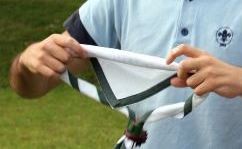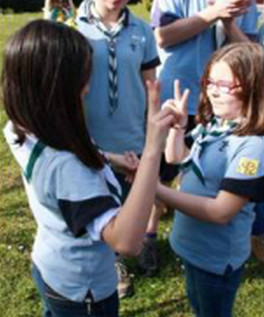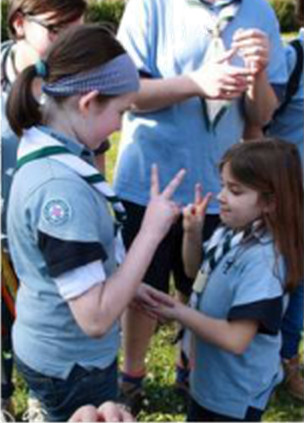The Neckerchief. What is it and why is it used?
The neckerchief, or scarf, represents the Scout Promise to uphold the Scout beliefs and behave like a true Scout. It is a triangular shaped scarf that you roll up and place on top of the collar of your top, positioning it so that the pointed corner is at the back. You join the two ends at the front with a fastener that has a special name: a woggle.
For those who start this adventure at a young age, the Promise is usually made in their first years of being part of the Scout pack. For cubs, making the promise is exciting because the occasion takes place in a beautiful setting, making the occasion a special event, and the ceremony is uniquely for the trainee who is about to take this major step.
In our group, one of the youngsters made his promise this Christmas and it was a very important day for him, perhaps the best day yet since he came into the world of Scouting.

Regardless, if you do come into this world a bit later - like as is my case - you have time to make the Promise. It is also not obligatory. Everybody does it when they feel ready and is truly in agreement with the philosophy.
In more detail...
The two ends of the neckerchief hang on the chest and are joined together with a woggle. Their isn't one standard woggle, it is personal to each person and can be personalised to the individuals taste: it is normally made out of wood, but other types exist. For example in our group, most are wooden but others have recreated the fleur de lis shape - the Scout emblem - with jewellery wire. Or a few others have made it with climbing rope.
If you do not yet have the aforementioned materials, another way is to simply make a knot in the neckerchief. But this knot must be a special knot, “the friendship knot", a clear representation of the friendship that exists between the scout members.
Today it is none other than a symbol that links together everybody who has made the Promise. In some groups, it is even worn from the start, before having made the Promise. Once the Promise is made it is turned around to show the colours of the group to which the person belongs, signifying in this way that they have agreed to follow the Scout ideology; that they have made the Promise and understand the Scout law.
In other groups, the neckerchief is not so symbolic, it is more about the flor de lis emblem, which is worn on the left-hand side of the polo shirt. In other words, they use the neckerchief more as an element of identification for the group and they reserve the right to wear the emblem for when they have made the Promise and have committed themselves to the Scout ways. This situation however is not the most common.
Symbolism
Each neckerchief has a meaning and there are different colours according to the association, federation or group to which you belong. The colours represent the symbolism, the mysticism of a collective that supports each other, immerses themselves in nature, who belong to a congregation... with ancient traditions.
As you will read below, the neckerchief is also an identifying element. In our group, the Hercules 283 Scout group, our neckerchief has a white background which represents scout purity and the colour green represents nature, because as scouts, we are really involved in nature.

Identity
Having different colours allows, as I have said, for there to be an element of identity, with the colours themselves belonging to a particular group. The colours are not the same. Each group chooses their own, according to the symbolism they want to give and as long as it does not coincide with another combination of colours that already exists.
It should be noted that the following colours can never be used, and I'll explain why:
- Purple: is reserved for the international Scout body.
- Salmon Pink: is reserved for the teachers who achieve the Wood Badge.
- Red and bright yellow: this combination is reserved for the Scouting federation in Spain, and is already used for the Scouts who represent Spain at the different functions and activities
- Steel blue, red and bright yellow: this combination is reserved for the ASCE federation, for its members or those who represent the federation in public ceremonies or activities.

How was it born?
The creation of this feature, the neckerchief or scarf, which today forms part of the Scout uniform with a simple symbolic function, dates back to the era of the old cowboys. This could sound like nonsense but it makes sense: in the olden days these characters used it to protect themselves from the cold, the wind, or as a towel if it was necessary.
Because of this, the first Scouts used this garment for the same function, and even to splint a broken limb if it ever happens during exploration, or to use as a tool to filter water.
The most common method of transporting this tool - to have on hand in case it was needed - was to carry around the neck, and so it has been from then until now.
Evidently its usage has changed, but it is interesting to know that previously it fulfilled a bigger role than just symbolism as it does today, and it is good to have something that reminds us who those first scouts were.

I believe I have written a clear post, so that you can discover a bit more about the Scouting culture. I think it is a garment that has always been curious for all of us who don't know about the Scout world. Now that I am discovering all these little things, I want to share it with you to try and awaken your curiosity, and encourage you to do a bit more research yourself.
The photos in this post, are of some of our children in the Hercules 283 scout group from A Coruña, Spain, from when they decided to make the Scout promise.
Photo gallery
Content available in other languages
Want to have your own Erasmus blog?
If you are experiencing living abroad, you're an avid traveller or want to promote the city where you live... create your own blog and share your adventures!
I want to create my Erasmus blog! →







Comments (0 comments)